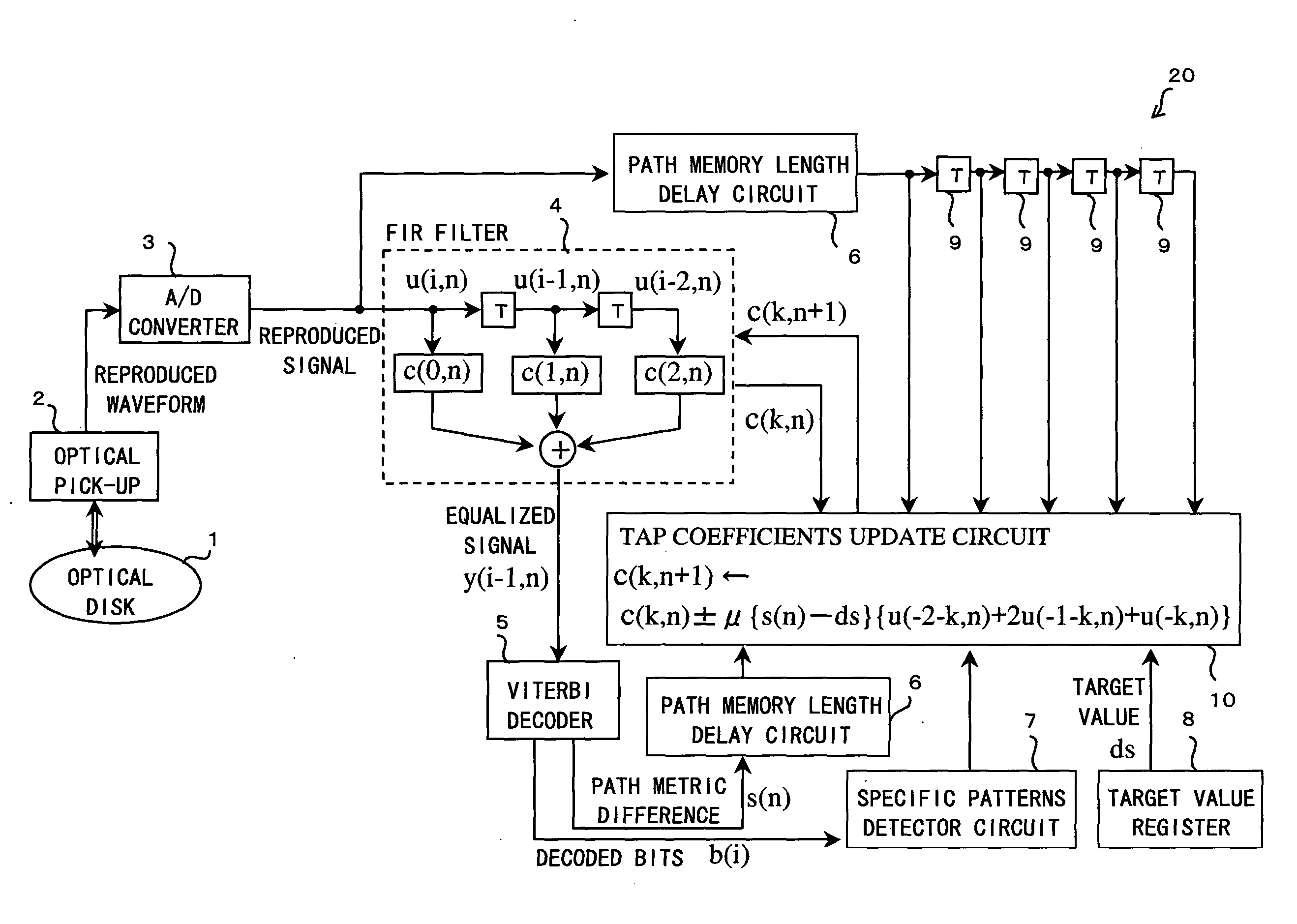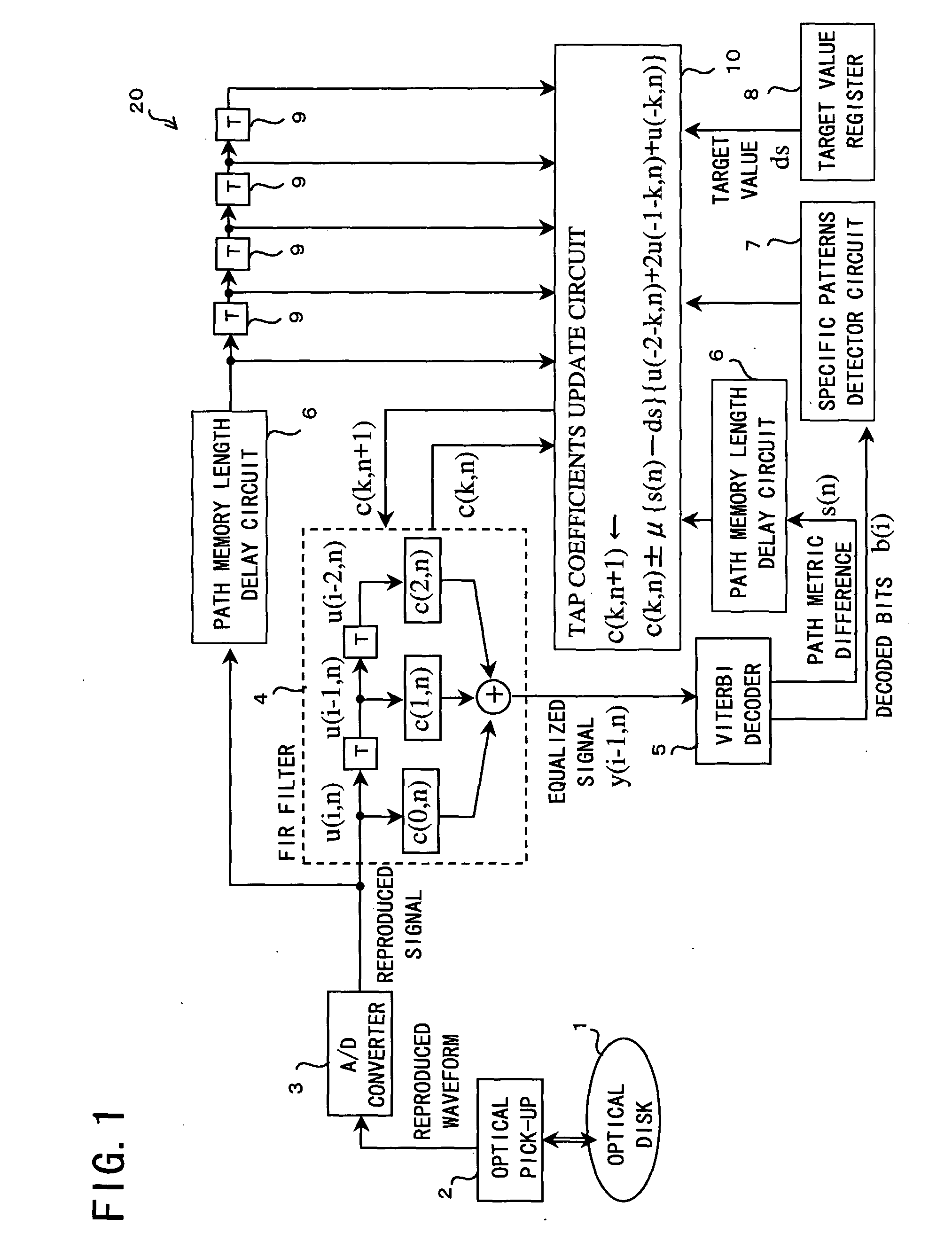Adaptive waveform equalization for viterbi-decodable signal and signal quality evaluation of viterbi-decodable signal
a technology of adaptive equalization and viterbidecodable signal, which is applied in the field of adaptive equalization of the waveform of a reproduced signal, can solve the problems of long start-up time, complex start-up process, and inability to provide the lowest error rate of equalization, so as to achieve simple arrangement, evaluate the quality of the digital signal, and high accuracy
- Summary
- Abstract
- Description
- Claims
- Application Information
AI Technical Summary
Benefits of technology
Problems solved by technology
Method used
Image
Examples
embodiment 1
[0075] The following will describe a first embodiment of the present invention with reference to FIGS. 1 to 10.
[0076]FIG. 1 is a block diagram showing an arrangement of an optical disc reproducing device (information reproducing device) 20 incorporating a waveform equalizing device according to the present invention. The optical disc reproducing device 20 reproduces data on an optical disc 1 and includes an optical pickup 2, A / D converter 3, FIR filter 4, Viterbi decoder 5, path memory length delay circuits 6, specific patterns detector circuit 7, target value register 8, T-delay elements 9 (T here and in the following description refers to one channel bit time of a reproduced signal), and tap coefficients update circuit 10.
[0077] The optical disc 1 has a mark pattern recorded thereon based on d=1 RLL (Run Length Limited) coding, such as S(1,7) RLL coding, that is, modulation with the shortest mark length of 2T.
[0078] The optical pickup (reproduction means) 2 reproduces an analog...
embodiment 2
[0168] The following will describe a second embodiment of the present invention with reference to FIG. 11. Here, for convenience, members of the present embodiment that have the same arrangement and function as members of embodiment 1, and that are mentioned in that embodiment are indicated by the same reference numerals and description thereof is omitted.
[0169] An optical disc reproducing device 21 of the present embodiment adjusts equalization properties using an optical disc 1′ on which a known bit pattern is stored. The known bit pattern is stored as a reference bit pattern in a reference bit pattern memory 11. The optical disc 1′ is assumed to have an equalization properties adjusting track in which the known bit pattern is stored.
[0170] When the known bit pattern is reproduced from the optical disc 1′, the same bit pattern b′(i) as the reproduced known bit pattern is fed to the specific patterns detector circuit 7 from the reference bit pattern memory 11 in synchronism with ...
embodiment 3
[0241] The following description will describe a third embodiment of the present invention referring to FIGS. 15 to 20.
[0242] The signal quality evaluation device (circuit) of the present invention evaluates quality of a digital reproduced signal, that has not been subjected to the signal process for Viterbi decoding, according to the path metric difference.
[0243] Thus, the signal quality evaluation device is applicable to a device which performs Viterbi-decoding signal reproduction, or a device which does not actually perform the signal reproduction but is based on the Viterbi-decoding reproduction. That is, the signal quality evaluation device can be preferably installed to an optical disc reproducing device, a magnetic recording / reproducing device such as a hard disk device and a magnetic tape device, and a communication data receiving device. For example, if the signal quality evaluation device is installed to the optical disc reproducing device in combination with a controlli...
PUM
| Property | Measurement | Unit |
|---|---|---|
| weights | aaaaa | aaaaa |
| memory length | aaaaa | aaaaa |
| threshold | aaaaa | aaaaa |
Abstract
Description
Claims
Application Information
 Login to View More
Login to View More - R&D
- Intellectual Property
- Life Sciences
- Materials
- Tech Scout
- Unparalleled Data Quality
- Higher Quality Content
- 60% Fewer Hallucinations
Browse by: Latest US Patents, China's latest patents, Technical Efficacy Thesaurus, Application Domain, Technology Topic, Popular Technical Reports.
© 2025 PatSnap. All rights reserved.Legal|Privacy policy|Modern Slavery Act Transparency Statement|Sitemap|About US| Contact US: help@patsnap.com



